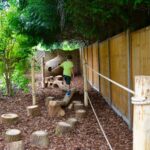Gardening can be a fun and educational activity for kids of all ages. When designing a garden for children, it’s important to consider their interests, abilities, and safety. By creating a space that is inviting and engaging, kids can learn about plants, insects, and the environment while also enjoying the outdoors.
One key element of garden design for kids is to choose plants that are easy to grow and maintain. Flowers like sunflowers, marigolds, and zinnias are colorful and simple to care for, while vegetables like tomatoes, cucumbers, and carrots can be exciting to watch grow and harvest. Herbs like mint, basil, and parsley are also great options for kids to grow and use in cooking.
Incorporating sensory elements into the garden can make it more appealing for kids. Consider adding plants with different textures, scents, and tastes, such as fuzzy lamb’s ear, fragrant lavender, and juicy strawberries. Creating a sensory garden allows children to engage all of their senses while exploring and learning in the garden.
Another important aspect of garden design for kids is to provide opportunities for imaginative play. Incorporating a playhouse, sandbox, or fairy garden into the design can encourage children to use their creativity and play outdoors. Adding whimsical features like colorful stepping stones, a birdhouse, or a DIY scarecrow can also make the garden more enchanting for kids.
To keep kids safe while gardening, be sure to choose non-toxic plants, eliminate any sharp or poisonous plants, and provide proper tools and equipment for children to use. Teaching kids about proper garden safety practices, such as wearing gloves and staying hydrated, can also help prevent accidents and injuries while gardening.
Lastly, involving kids in the planning and maintenance of the garden can help them develop a sense of ownership and responsibility. Encourage children to help plant seeds, water plants, pull weeds, and harvest vegetables. By involving kids in the process, they can learn valuable gardening skills and develop a lifelong love of gardening and nature.













